Experimental self-propelled artillery installation AMX-10M ACRA (France)
Recall, the ACRA program was launched in 1961 year, the organization Atelier de construction de Puteaux (APX) was appointed the lead developer of the project. By this time, the American industry created a MGM-51 Shillelagh guided missile, launched through the barrel of a special 152-mm cannon. The French military, having learned about this development, demanded to create a similar weapon. The project, during which the required rocket was to be developed, was called Anti-Char Rapide Autopropulsé (“Anti-tank self-propelled high-speed [weapons]”). As part of the ACRA program, it was necessary to create a guided missile, guidance systems and a new modification of the existing tank.
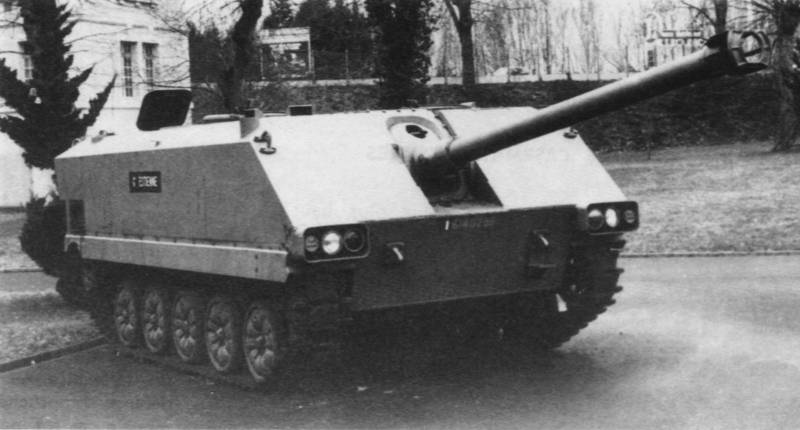
The first prototype SAU AMX-10M ACRA. Photo Chars-francais.net
Initially, the carrier of the ACRA rocket was planned to make a special modification of the main tank AMX-30. Subsequently, there was a proposal to develop a new machine with guided missile weapons. On the basis of one of the newest models of armored vehicles, it was necessary to create an original self-propelled artillery installation with the required weapons. As a basis for the new ACS, it was proposed to use the AMX-10P infantry combat vehicle being developed by GIAT. By changing the existing units and installing the new units, the existing BMP was planned to be altered into an ACS with a launcher.
The project of the promising "rocket self-propelled gun" was designated AMX-10M ACRA, reflecting the type of the base machine, as well as indicating the type of main armament. The development of such an ACS began in the 1966 year, shortly after the formation of the overall appearance of the base infantry fighting vehicle. Over the next few years, two projects were developed in parallel. Proceed to the construction of an experienced self-propelled succeeded only in 1970 year.
Perspective AMX-10P BMP had a distinctive appearance associated with the need for transportation and fire support of soldiers on the battlefield. The proposal to use such a machine as a basis for self-propelled artillery guns entailed the need to significantly rework the existing structure. The authors of the new project had to change the design and layout of the hull, redesign the power plant and transmission, and also provide for the possibility of installing the required weapons.
The AMX-10P had a frontal part, formed by two inclined armor plates and paired with vertical sides. In the new project, a different hull design was proposed with similar protection indicators. The front part of the body received a rectangular lower sheet of reduced width with the top expanding part, located with a slight inclination forward. Above it were two frontal parts mounted at an angle to the vertical. Between the two frontal parts there was an embrasure for mounting the gun, covered with its own mask. The sides consisted of large vertical sheets and small inclined panels at the top. From above the case was closed by a horizontal roof. The feed consisted of a vertical sheet with several protruding aggregates.
Shells of aluminum rolled metal armor were used as part of the hull, providing all-view protection against small arms and artillery shell fragments. Frontal projection was supposed to withstand the shelling of 23-mm automatic guns. A similar level of protection had an armored corps base BMP AMX-10P.
The need to use completely new weapons led to a radical redesign of the layout of the internal volume of the body. The infantry fighting vehicle, taken as a basis, had a front engine and transmission compartment, and the central and aft parts of the hull were given for the placement of the landing force. In the AMX-10M ACRA project, the front compartment of the corps was to accommodate a combat compartment combined with a command compartment. Feed was given for the installation of the engine and transmission units. Such changes, in particular, led to some changes in the chassis design.
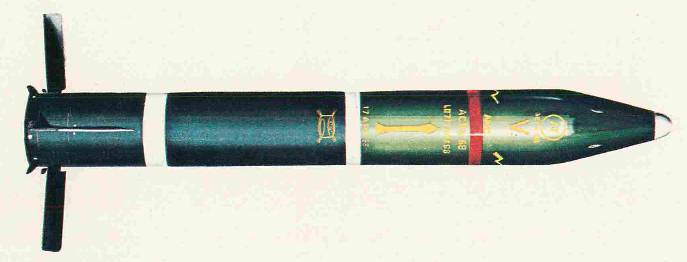
General view of the ACRA rocket. Photo by Aw.my.com
Accurate information about the composition of the power plant "rocket self-propelled gun" is not available, but there is every reason to believe that the engine and transmission were borrowed from the existing project. In this case, the ACS could be equipped with a Hispano-Suiza HS 115 diesel engine with 280 horsepower. The available transmission was located next to the engine and transmitted its torque to the drive wheels, which in the new project were transferred to the rear of the hull.
The AMX-10M ACRA ACS has received an existing undercarriage with some notable changes. It was based on five support rollers of average diameter on each side, equipped with an individual torsion bar suspension. In connection with the rearrangement of the hull and the transfer of the power plant, the drive wheels, in contrast to the existing BMP, were located in the rear, the guides in the front part of the board. The upper branch of the caterpillar was supposed to lie on four supporting rollers.
In front of the body was the main gun self-propelled gun, the trunk of which was displayed through the embrasure of the frontal sheet and was covered with a mask of a round shape. According to reports, in the framework of the AMX-10M ACRA project, it was decided to abandon the development of a new gun, using the existing system created earlier for the AMX-30 ACRA tank. Thus, the finished gun launcher received a set of new equipment, after which it could be mounted in the body of the self-propelled gun.
The main weapon of the tank and self-propelled guns of the new types was to be the original gun-launcher, adapted for firing special active-projectile and launching guided missiles like ACRA. Such requirements led to the formation of a specific appearance of weapons. The gun received a barrel of medium length caliber 142 mm. It is noteworthy that in the French practice this caliber was used in only two armored vehicles projects: similar weapons were received by the ACRA launch vehicle and the AMX-30 EBG armored engineering vehicle. It should be noted that in the latter case it was a launcher for unguided rockets. Probably, the caliber 142 mm was chosen during the development of the rocket as a reasonable compromise between the compactness of the product and the level of technological development.
The increased caliber of the gun should have led to a corresponding increase in the recoil momentum. Such features of the project led to the development of a muzzle brake that can reduce the momentum acting on the tank or self-propelled gun. On the muzzle of the barrel was placed box-shaped construction of several metal sheets of different shapes and sizes. During the shot, such a brake had to send powder gases to the sides and back relative to the barrel, thereby compensating for a part of the recoil impulse. Most of the remaining impulse was absorbed by the recoil devices.
Within the framework of the ACRA program, two 142 mm caliber ammunition were developed, namely, a guided missile, which was the main element of the entire project, and an additional high-explosive fragmentation projectile. The missile was considered as a means of defeating enemy armored vehicles at distances exceeding the range of its effective fire. The unguided projectile, in turn, was supposed to be an addition to the rocket and used to attack infantry, fortifications, etc.
The ACRA type missile was a guided munition with a conical head fairing and a cylindrical body. The maximum case diameter was 142 mm, length - 1,22 m. The starting weight of the product - 26 kg. The head part of the rocket body contained a cumulative warhead. A hexogen charge weighing 2 kg with a conical notch could penetrate up to 380 mm of homogeneous armor. The central compartment of the hull was given for the installation of a solid fuel engine. An interesting fact is that the engine casing was placed in the center of the rocket, and its tail end was completed with a long tube, with the help of which the jet gases were discharged through a nozzle in the rocket tail. The engine pipe passed through the tail hardware compartment. In the latter, there were eight planes laid out in flight with a span of 438 mm, as well as instrumentation guidance devices.
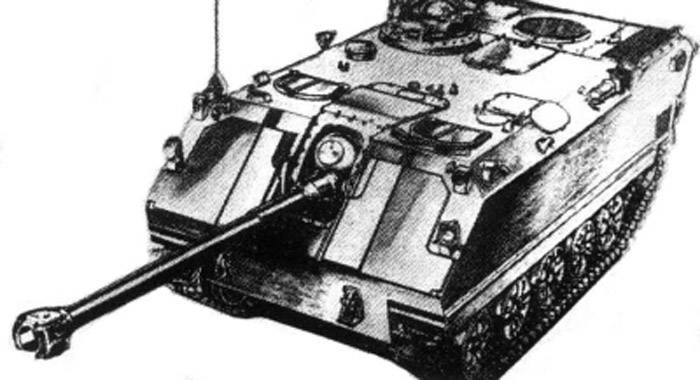
Scheme self-propelled guns with rocket armament. Figure Shushpanzer-ru.livejournal.com
The used solid-fuel engine had to throw the rocket out of the gun-launcher with an initial speed of 150 m / s. After the engine switched to the marching mode, bringing the flight speed to 500-550 m / s. The range of the ACRA product reached 3,3 km. Flight time to the maximum range - 7 seconds.
The ACRA project proposed guiding a guided missile at a target "along the line." It was assumed that the carrier vehicle will direct the “leading” beam of light to the target, which will be used by the rocket to hold it at the desired trajectory. Initially, it was planned to use a xenon lamp as a radiation source, but later decided to use a laser. An Nd: YAG emitter having an active medium in the form of an alumino-yttrium garnet doped with neodymium ions should have been placed on a tank or self-propelled gun and used to guide the rocket.
The flying guided missile had to follow its deviation from the required trajectory with the help of four photocells placed on the tail end of the hull. Having determined the deviation, the automatics of the product should return it to the required trajectory. Doing a rocket with a laser beam continued until it hit the target.
For pointing guns when using rockets or shells self-propelled gun AMX-10M ACRA received a periscope sight. In addition, a laser emitter of the missile guidance system was installed in the mask of the weapon above the barrel. In the stowed position, the emitter lens was covered with a sliding cover. To use the rocket, it was necessary to point the gun at the target and turn on the laser paired with it, after which it was possible to launch the rocket. Using weapons control mechanisms, the gunner could hold an aiming mark on the target, which led to the preservation of the correct guidance of the laser beam.
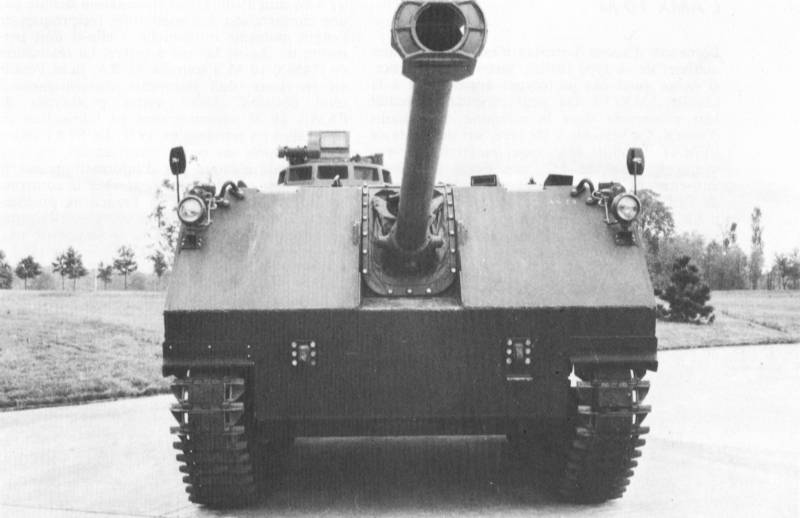
Prototype with commander turret. Photo Chars-francais.net
To defeat fortifications or other structures, as well as enemy manpower, the AMX-30 ACRA tank and the AMX self-propelled AMX-10M ACRA self-propelled gun were to use a new model projectile. Especially for the new gun, a 900 mm long shot with 21 kg mass and a 142 mm caliber shell with a 640 mm length and 15 kg mass was developed. 2 kg projectile weight accounted for an explosive. To stabilize in flight, the projectile was equipped with six open planes. At the stage of development of the munition, it was found that the barrel of medium length will not allow to obtain a high initial velocity and thereby seriously limit the firing range. To solve this problem, in the tail section of the projectile, its own jet engine appeared, which starts after exiting the barrel.
The 142-mm gun could independently propel the projectile up to the speed of 550 m / s. After leaving the barrel, the ammunition accelerated to the 700 m / s using its own engine. Due to the increased flight speed and the corresponding angle of elevation of the barrel, the high-explosive fragmentation projectile could fly to a distance of 8 km.
The entire crew of the self-propelled artillery of the new type was housed in a single fighting compartment, which occupied most of the corps. In front of the machine, to the left of the gun, was the workplace of the driver. The driver had to get into his place through the hatch in the roof, near which there was a set of periscope viewing devices. In a combat situation, the driver could follow the road using periscopes, on the march - to observe through the open hatch. To the right of the gun and the driver placed the gunner's place with its own hatch. This control post had a full set of instruments to monitor the operation of all systems, including the laser missile guidance device.
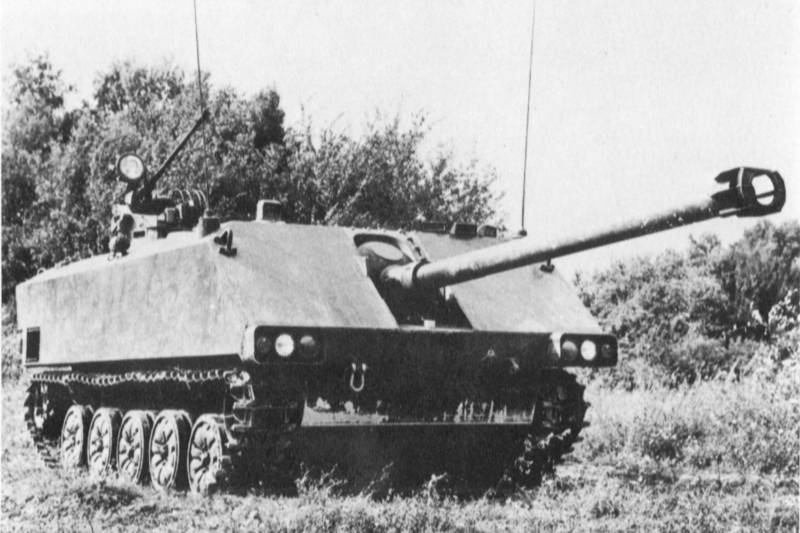
The third experienced machine, the AMX-10M ACRA, received the 20-mm gun. Photo Chars-francais.net
In the center of the case should have been charging. Next to his place were several shelves and stowage for ammunition. At the left behind the place of the commander was envisaged. Interestingly, as the AMX-10M ACRA project evolved, the additional equipment of the command station underwent significant changes. Thus, initially a simple hatch with a hinged lid was located above the commander’s seat. Later, on the site of the hatch, a commander's tower was installed with a large number of viewing devices providing all-round visibility. Finally, in the final version of the project, additional armament appeared on the commander's turret.
For protection against various threats to the self-propelled crew from a certain time it was proposed to use an automatic gun caliber 20 mm. Such weapons were mounted on a remote-controlled installation, mounted on the roof of the commander's tower. The design of the installation and the parameters of the gun made it possible to bombard both ground and air targets. 20-mm gun made it possible to fight with manpower, unprotected and lightly armored equipment of the enemy at distances from several hundred meters to kilometers. Thus, when attacking some targets in a certain range of ranges, the crew could not use the main weapon’s ammunition.
Being a seriously reworked version of an existing infantry fighting vehicle, the AMX-10M ACRA self-propelled guns had similar dimensions and weight. The hull length was at the level of 6 m, the width and height were about 2,8 m. The combat weight was approximately equal to 15 t. Saving the weight and the existing engine made it possible to get the maximum speed on the highway at 65 km / h with a power reserve of about 600 km.
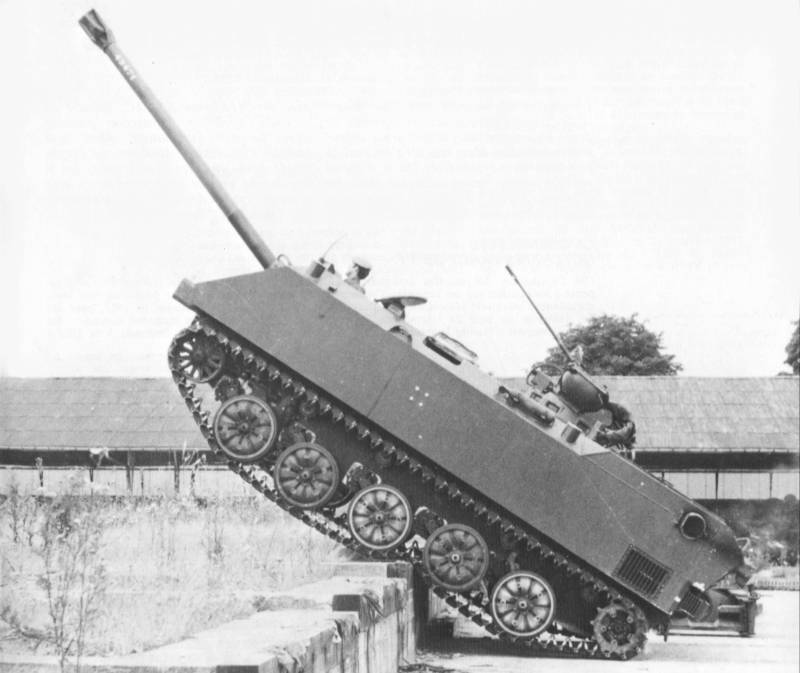
The prototype self-propelled climbs on the wall. Photo Chars-francais.net
The development of a promising self-propelled artillery installation was completed by the early seventies. In 1970, one of the enterprises of the French industry began to build the first prototype machine. According to some information, the first prototype of the AMX-10M ACRA differed from the subsequent experimental equipment in its simplified configuration. It was he who did not receive the commander's turret and some other details, right up to the canvas mask cover of the gun. In the same year, the first sample of self-propelled guns came to the test. In 1971, two other armored vehicles with a different configuration joined it. Soon, all three prototypes were brought to the testing of promising technology.
It should be noted that in the 1970, the AMX-10M ACRA self-propelled guns and the AMX-30 tank with similar missile and artillery weapons were released for testing. Thus, from a certain moment, two types of prospective armored vehicles were tested at the test site in parallel. This allowed us to speed up the work, as well as to compare the capabilities of two machines of different classes. The last factor was also of interest to the customer in the face of the French military department: in case of failure of one of the projects of the ACRA program, it was possible to continue work on the other.
During the tests, the basic design characteristics of both samples were confirmed. After some improvements and fine-tuning, the Anti-Char Rapide Autopropulsé rocket began to successfully target these targets and show the required probability of hitting the specified object. The firing range in theory was enough to fight all known tanks of a potential enemy, and the power of the warhead made it possible to penetrate the armor of at least most of these samples. If necessary, the ACS could use an active-missile projectile, expanding the range of combat missions to be solved.
Despite all the advantages, the ACRA project was not without flaws. So, its authors did not manage to solve the task set by the customer to expand the list of rocket carriers. The ACRA product was planned to be used both on armored vehicles and as part of the weapons of military helicopters. At a certain stage of development, it became clear that only 142-mm guns would be able to launch such missiles. Another problem was the high cost of the rocket. As of the early seventies, one guided missile cost about 1 million French francs.
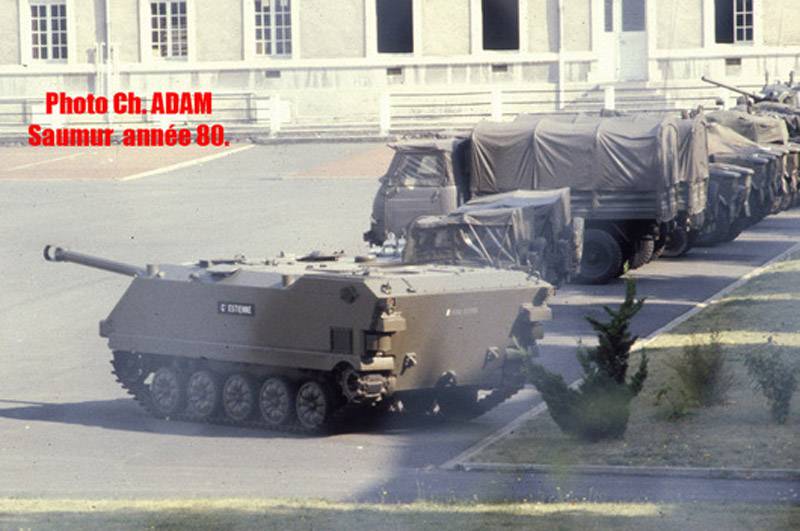
One of the experienced self-propelled guns on the museum site in Saumur, roughly 80-e. The package bundle suggests that this is the first prototype. Photo Maquetland.com
One of the most serious problems of a tank and rocket-propelled self-propelled guns was the specific target attack procedure. In preparation for the launch of the rocket, the crew had to stop, aim and launch guided munitions. Until it hit the target, the armored vehicle could not move from its place to avoid the displacement of the laser beam and the loss of aiming. Being motionless, the combat vehicle risked becoming an easy target for tanks, artillery or aviation the adversary.
According to the results of tests that continued until the beginning of 1972, the French Ministry of Defense decided to refuse to continue work on the Anti-Char Rapide Autopropulsé program. The models of armored vehicles built and tested at the test site showed acceptable characteristics, however, some features of such vehicles did not allow us to expect high efficiency in practical use. It was decided to curtail the development of such weapons in favor of other projects of a similar purpose.
Nevertheless, the company GIAT and other creators of projects of the ACRA family decided not to stop working and continued to improve the missile system on their own initiative. This work continued until the end of 1974. In just a few years of work, about 500 ACRA missiles were manufactured. Almost all of these products were consumed during testing. It is easy to calculate what was the total cost of production of experimental missiles, and understand the customer, who was not satisfied with the financial aspects of the project.
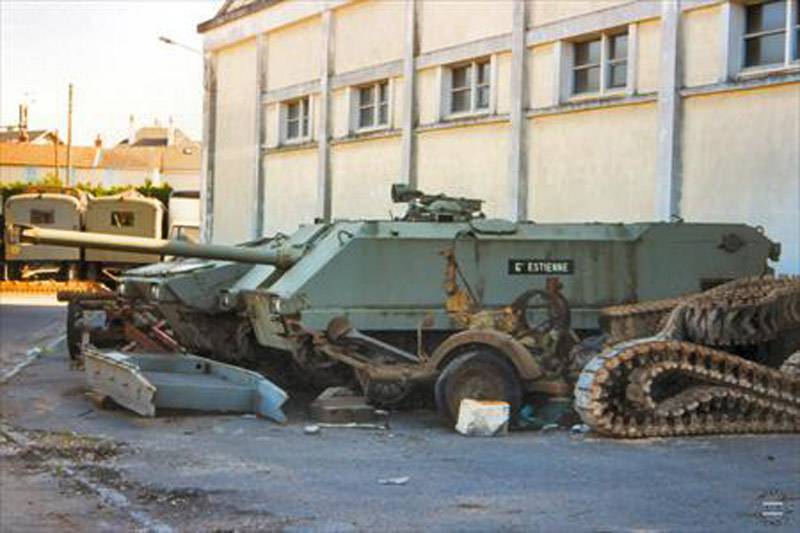
A more recent state of the experienced AMX-10M ACRA from the museum. Photo Forum.worldoftanks.ru
The latest test launches of guided anti-tank missiles for armored vehicles took place in December 1974 of the year. After that, all the work was stopped. One of the main reasons for this completion of the ACRA program was the success of newer projects. By this time, the industry of France and Germany managed to develop a joint project of the anti-tank missile complex HOT. Such a complex differed from the existing ACRA with enhanced technical and combat characteristics, and besides, it could be based on various self-propelled platforms. The future completion of work on the HOT system deprived the Anti-Char Rapide Autopropulsé project of any real prospects.
After the final abandonment of the ACRA project, all four prototypes built were left idle. They were of no interest to a potential customer and were not needed by manufacturers. Shortly after the project was closed, at least a few built cars were transferred to the armored vehicle museum in the city of Saumur. For a number of reasons, the received equipment was not included in the permanent exhibition, because of which it remained in the “reserves” and stood on the reserve sites. The last references to the existence of prototypes of the AMX-30 ACRA tank and AMX-10M ACRA ACS refer to the end of the nineties. Information about the current state of affairs in the museum and the prospects for unique samples of armored vehicles with combined missile and artillery weapons are missing.
AMX-10M ACRA self-propelled gun was the first and last built in France model of its class, capable of using not only artillery shells, but also guided missiles launched through the barrel of the gun. After the failure of the Anti-Char Rapide Autopropulsé project, the French military were disappointed in such ideas, which accordingly affected the further development of armored vehicles. Modern tanks of France AMX-56 Leclerc can only use unguided projectiles of several types, while guided anti-tank missiles are now weapons of other classes of technology.
On the materials of the sites:
http://chars-francais.net/
http://tanks-encyclopedia.com/
http://secretprojects.co.uk/
http://strangernn.livejournal.com/
http://shushpanzer-ru.livejournal.com/
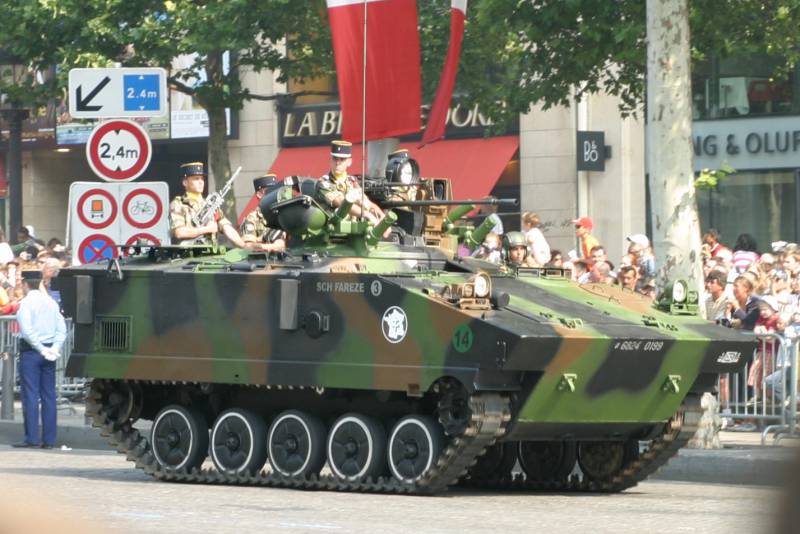
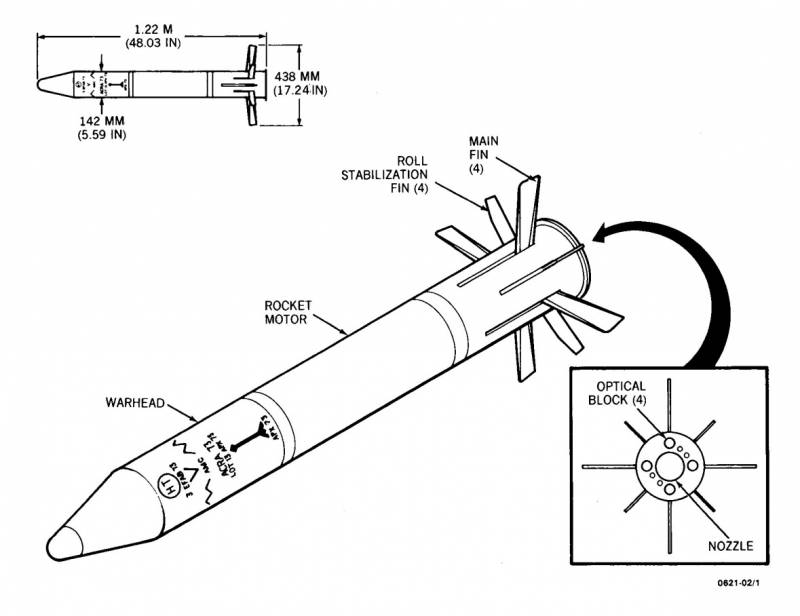
Information